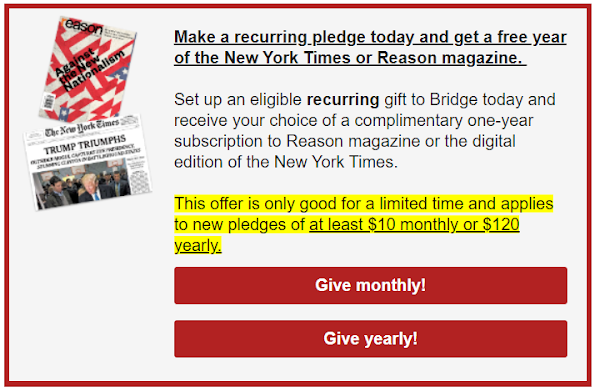Newsroom overview
A nonprofit, nonpartisan news organization, providing Michigan readers with daily, fact-driven journalism covering the state's issues, including diverse people, politics, and economics
Ypsilanti, Detroit, and Lansing, Michigan
2011
2019
655,000
9,000
24 percent
With just over 9,000 members in November 2022, Bridge Michigan has one of the largest local membership programs in the U.S. (excluding public radio membership). Their annual rolling retention rate has typically been about 70%, a little over the median rate at News Revenue Hub, of whom they are a client.
Although Bridge Michigan’s year-end campaign in 2021 was very successful, they were churning members much more than they were used to, according to membership and engagement director Amber DeLind. Retention was down from about 70% to the low 60s. At the same time, growth had slowed. As a result, Bridge Michigan’s number of members was flat for close to eight months.
They knew they needed to start trying some new things to address that. Bridge Michigan embraced a test-and-learn mindset years ago, and they kicked that approach into gear. This case study will walk through some of the new membership offerings they tried that brought them back to a 73% retention rate in 2022.
Why this is important
Like many U.S.-based newsrooms, Bridge Michigan struggled with a post-pandemic and post-Trump plateau.
Continuing to grow and retain members isn’t something that happens passively, especially when a membership program gets past its buzzy first couple years. Membership is not a “set it and forget it” product.
Even if a newsroom isn’t seeing a plateau or rising churn, they should still be continually looking for ways to increase the value of membership for their members. This case study offers several examples of ways to diversify your membership offering to retain the members you have and attract new members who might not be interested in your core product.
What they did
Three strategies, coupled with rising interest in political news leading up to the midterms, helped Bridge Michigan get back to the same growth and retention rates they were seeing before the pandemic:
- They implemented fresh newsletter strategies that gave them a larger pool of potential members to reach by email.
- They launched a book club that is still running today.
- They offered time-limited incentives.
New newsletters
The Bridge Michigan team recognized that if they wanted to grow their membership program, they also needed to draw more people into the mid-funnel — and in order to reach people that they had not yet managed to reach, they probably needed to offer a different editorial product.
They hypothesized that although comprehensive coverage of Michigan is what they’re known for, there might be readers who don’t want a general interest newsletter but would be interested in a more niche topic. In September 2021, they launched bimonthly newsletters focused on topics such as business, health, and the environment.
During their summer and fall membership campaigns, they sent specific appeals to these newsletter lists, highlighting the coverage they had done on the beat that year. In 2022, they also held at least two virtual events related to each beat in order to give high-interest readers an opportunity to engage more deeply with the reporting.
Book club
As the full scope of the pandemic came into view, Bridge Michigan canceled all its upcoming in-person events in March 2020..Still, they wanted to find a way to connect with readers. Why not try a virtual book club?
They resurfaced an early pandemic article highlighting several Michigan–authored books and invited readers to vote on which of those books they wanted to read first. Bridge Michigan then sent out an email announcing the book, told people where they could get it, and set a May 2020 date for the Zoom discussion.
The author joined and 75 people showed up — a “shockingly large” group, DeLind said. Buoyed by overwhelmingly good feedback, they immediately began planning the next meeting.
In planning, they surveyed attendees, asking questions such as:
- What did you like best?
- What did you like least?
- What suggestions do you have for improving?
They also invited Bridge Michigan readers to suggest books for the book club, using the following criteria: the author needed to be from Michigan, the book needed to be about Michigan, or the book needed to be on a topic related to Michigan.
DeLind used her membership budget, normally allocated for in-person events, to purchase digital versions of the book club books, which members could request for free. They still offer this popular perk today.
Time-limited incentives
Bridge Michigan tried out digital contributor rewards for the first time in March 2020, giving new members who gave $120 or more a year (on a monthly or annual basis) a free one-year subscription to The New York Times or Reason, a center-right magazine. (DeLind credits Sam Hoisington, their former program manager at News Revenue Hub, with the idea.)
Bridge Michigan has since offered this as a benefit four other times: in May 2020; their December 2020 year-end campaign; their December 2021 year-end campaign; and to only highly-engaged readers in February 2022. Although they don’t have the budget to offer this sign-up benefit all the time, DeLind says that’s not necessarily an issue — she thinks that it’s a more effective benefit when offered during specific times of year.

The results
None of these strategies would have been enough on their own to restore Bridge Michigan’s growth and retention to its steady pre-pandemic levels. But together, coupled with more standard growth and retention tactics, Bridge Michigan is back at a 73% retention rate.
The niche newsletters they began offering in 2021 have exceeded expectations. They had a goal of 5,000 subscribers for each of their five newsletters (Business Watch, Education Watch, Environment Watch, Health Watch, and Politics Watch), and they’ve reached that for all of them. Politics Watch and Health Watch reached double the goal. They plan to launch beat-specific membership drives in 2023.
As of August 2022, they’ve held 13 virtual book club discussions with an average of 100 people at each discussion (about 75 percent of them members), including the author. They’ve had 1,613 people participate in the book club. They’ve received 7,165 requests from members for the free book downloads.
They also launched a Facebook group to discuss the book, which has topped 600 participants.
In their member onboarding survey, they ask people why they became a member and “the book club is far and away the biggest reason they join,” DeLind says — even though the book club isn’t member-only. And when DeLind asked members what benefit they enjoyed most in their 2021 year-end survey, the free e-book benefit was the most popular benefit across all tiers, after “I don’t need any benefits, I just want to support your journalism.”
Membership is promoted aggressively through the book club. First, it’s the only way to get the free download. They also include a membership ask in the book club announcement, the “thank you” they send afterwards, and the recording that they share with all of their readers. They’ve raised $9,000 in membership revenue from book club callouts so far.
“I keep anticipating that interest in this will wane as people return to normal life,” DeLind says. So far, that hasn’t been the case. “It’s additive to your interest in Bridge because you like to read, but it’s enough removed that it feels like an escape,” DeLind said when hypothesizing why book club interest remains high.
Meanwhile, of the 321 donations made during a contributor-rewards campaign, 199 of them are still active. Seventy-three percent of the people who joined during a contributor-rewards gift period have stayed, compared with 67 percent for all members in the same time frame.
What they learned
Readers are looking for levity, too. DeLind says that the book club’s success showed them that not all membership benefits or reader engagement activities have to be directly related to their journalism. Sometimes being “fun” is enough. By focusing on books about Michigan or by authors from Michigan, they’ve been able to tap into state pride, too.
You can offer benefits that aren’t about you. The New York Times and Reason subscriptions don’t have any connection to Bridge Michigan. But they knew their readers were interested in both state and national news and offering the subscriptions would not cost Bridge Michigan much to offer. (The full-price Reason subscriptions are $14 and they got the New York Times subscription at a steep discount of $25 each. Bridge Michigan taps their budget for membership benefits to cover the costs.)
Keep things interesting. It’s hard to keep existing members engaged and hook new members if you’re sending them the same messages over and over again – and it’s a lot easier to come up with fresh messaging if you have something new to talk about, even if it’s small. From the book club to the beat-related events, there’s always something new for Bridge Michigan to tell members and potential members about.
Key takeaways and cautionary notes
You need to have the basics in place first. Creative tactics like these aren’t worth it unless you’re maximizing the more standard strategies, such as a strong newsletter onboarding series, a strong member onboarding series, and an “always be fundraising” mindset that includes multiple campaigns a year and tailored membership asks everywhere you can put them. Bridge Michigan has all of these in place, ensuring that it avoids easily preventable membership losses and is capturing every potential member that it can.
When growth slows, you might have to do some things differently. Until 2021, Bridge Michigan’s membership growth happened primarily through its free general newsletter. That’s still a steady source of membership growth, but the team correctly recognized that to serve other audiences, it might need a more niche product. You can start small, with just one newsletter or similar product on a beat that attracts higher-than-average readership.
Other resources
- News Revenue Hub, case study: ”Always be fundraising’: How Bridge Michigan built a million-dollar membership program”
- Membership Guide, case study: How Bridge Michigan tested its way to membership growth


